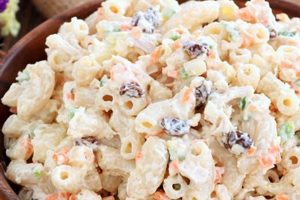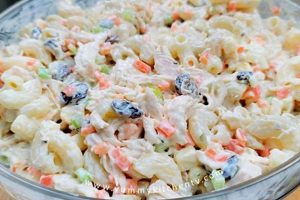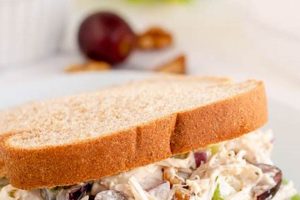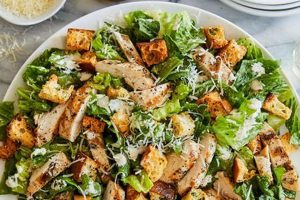A dish combining cooked chicken, mango, and other ingredients, often including mayonnaise or a similar dressing, creates a flavorful and refreshing salad. Variations exist, incorporating diverse vegetables, nuts, and seasonings, resulting in a wide range of flavor profiles, from sweet and savory to spicy and tangy. A typical preparation might involve diced grilled chicken breast, chunks of ripe mango, red onion, cilantro, and a lime-cilantro vinaigrette.
This type of salad offers a nutritious and satisfying meal option. The chicken provides protein, while the mango contributes vitamins, antioxidants, and natural sweetness. The inclusion of fresh vegetables adds further nutritional value. The adaptable nature of the dish allows for customization to suit various dietary needs and preferences, making it suitable for a light lunch, a picnic dish, or part of a larger buffet spread. Its popularity has grown in recent decades, reflecting increasing interest in global cuisine and lighter, healthier meal choices.
Further exploration will delve into specific variations of this salad, providing detailed instructions, nutritional information, and tips for ingredient selection and preparation.
Tips for a Superior Mango Chicken Salad
Optimizing ingredient selection and preparation techniques elevates this dish from simple to exceptional. Attention to detail ensures a balanced flavor profile and a pleasing textural experience.
Tip 1: Mango Selection: Ripe, but not overripe, mangoes provide optimal sweetness and texture. Avoid mangoes that are excessively soft or have bruised areas.
Tip 2: Chicken Preparation: Grilled or roasted chicken enhances the salad’s flavor. Pre-cooked rotisserie chicken offers a convenient alternative. Ensure the chicken is cooled completely before combining with other ingredients.
Tip 3: Balancing Flavors: A counterpoint to the sweetness of mango is essential. Acidity from lime juice or red onion, along with the savory notes of cilantro or mint, create a well-rounded flavor profile.
Tip 4: Enhancing Texture: Consider adding toasted nuts, such as almonds or cashews, for textural contrast. A sprinkle of toasted coconut flakes adds a subtle sweetness and crunch.
Tip 5: Dressing Considerations: A light vinaigrette complements the delicate flavors of the salad. Avoid heavy, creamy dressings that can overpower the other ingredients.
Tip 6: Ingredient Proportions: Maintain a balance between the chicken, mango, and other ingredients. Too much of any single ingredient can detract from the overall harmony of the dish.
Tip 7: Chilling and Serving: Allow the salad to chill for at least 30 minutes before serving to allow the flavors to meld. Serve chilled on a bed of greens or in a sandwich wrap.
By following these guidelines, one can achieve a mango chicken salad that is both flavorful and visually appealing, maximizing enjoyment and delivering a culinary experience that satisfies the palate.
These tips provide a foundation for creating a truly exceptional mango chicken salad. Experimentation with different ingredients and techniques is encouraged to personalize the recipe and discover new flavor combinations.
1. Ingredients
Ingredient selection directly impacts the final flavor profile and overall quality of a mango chicken salad. The interplay between core componentschicken, mango, and complementary elementsdefines the dish’s character. Chicken, the primary protein source, benefits from thoughtful consideration. Grilled or roasted chicken offers a deeper, smokier flavor, while poached or shredded rotisserie chicken provides a milder taste and different texture. Mango selection is equally crucial. Ripe, fragrant mangoes deliver optimal sweetness and a vibrant tropical essence. Underripe mangoes result in a tart, less desirable outcome. The interplay between these primary ingredients establishes the foundation upon which other flavors build.
Beyond the core components, supporting ingredients play a vital role in balancing and enhancing the salad. Red onion adds a sharp, pungent contrast to the sweetness of the mango, while cilantro or mint contribute herbaceous freshness. Nuts, such as almonds or cashews, introduce textural complexity and a subtle richness. The dressing further influences the final product. A light vinaigrette, often incorporating lime juice, ginger, and a touch of honey, complements the delicate flavors without overpowering them. Conversely, a heavy, mayonnaise-based dressing can mask the nuanced flavors of the chicken and mango.
Careful ingredient selection is paramount to a successful mango chicken salad. A harmonious balance of flavors and textures, achieved through conscious choices, elevates this dish from simple to exceptional. Understanding the impact of each ingredient allows for informed decisions, enabling culinary creativity and ultimately, a more satisfying culinary experience. Neglecting the importance of ingredient quality can lead to a bland or unbalanced salad, highlighting the direct correlation between ingredient choices and the final product’s appeal.
2. Preparation
Preparation methods significantly influence the final quality and enjoyment of mango chicken salad. Proper techniques enhance flavor development, optimize texture, and ensure food safety. From initial ingredient handling to final assembly, careful execution of each step contributes to a superior culinary outcome.
- Chicken Handling and Cooking
Chicken preparation lays the groundwork for the entire salad. Proper cooking ensures both safety and optimal flavor. Grilling or roasting imparts a smoky char, while poaching or baking yields a more tender result. Regardless of the chosen method, achieving a fully cooked yet moist chicken is essential. Dicing or shredding the chicken into bite-sized pieces ensures even distribution throughout the salad and facilitates a pleasant eating experience. Overcooked chicken becomes dry and tough, detracting from the salad’s overall appeal.
- Mango Processing
Mango preparation requires precision and care. Careful peeling and dicing maximize yield and minimize waste. Uniformly sized mango pieces contribute to a visually appealing and evenly textured salad. Overripe mangoes become mushy and difficult to handle, while underripe mangoes lack the desired sweetness and can be fibrous. Proper handling preserves the mango’s delicate texture and vibrant flavor.
- Ingredient Combining and Chilling
The order and method of combining ingredients impact the final flavor and texture of the salad. Incorporating the dressing shortly before serving prevents the salad from becoming soggy. Gentle tossing ensures even distribution of ingredients and dressing without bruising delicate components. Chilling the salad allows flavors to meld and enhances refreshment.
- Presentation and Serving
Presentation elevates the dining experience. Serving the salad on a bed of fresh greens adds visual appeal and textural contrast. Garnishing with chopped nuts or fresh herbs provides a finishing touch that enhances both flavor and aesthetics. Thoughtful plating transforms a simple salad into a visually captivating dish, increasing its perceived value and enjoyment.
Precise preparation techniques elevate mango chicken salad from a basic dish to a culinary delight. Attention to detail throughout the process, from ingredient selection to final plating, ensures a harmonious balance of flavors, textures, and visual appeal. Careful execution of each step contributes to a more satisfying and enjoyable culinary experience, emphasizing the direct relationship between preparation and the final product.
3. Flavor Balance
Flavor balance represents a crucial element in a successful mango chicken salad recipe. The interplay of sweet, savory, acidic, and spicy elements determines the overall taste experience. A well-balanced salad offers a harmonious blend of these flavors, preventing any single component from dominating. Achieving this balance requires careful consideration of ingredient selection, proportions, and preparation methods.
- Sweetness of Mango
Mango’s inherent sweetness serves as the foundation of the flavor profile. Ripe mangoes provide the ideal level of sweetness without being cloying. Balancing this sweetness with other contrasting flavors prevents the salad from becoming overly sugary. The variety of mango also influences sweetness; some varieties are naturally sweeter than others. This natural sugar content interacts with other ingredients, impacting the overall flavor balance.
- Savory Element of Chicken
Chicken provides the savory counterpoint to the mango’s sweetness. The cooking method influences the chicken’s flavor; grilled or roasted chicken imparts a smoky depth, while poached chicken offers a milder taste. The savory notes of the chicken prevent the salad from becoming overly sweet, creating a more complex and satisfying flavor profile. The choice of chickenbreast, thigh, or a combinationalso affects the overall savory contribution and texture.
- Acidity as a Balancing Agent
Acidity plays a vital role in balancing both the sweetness of the mango and the richness of the chicken. Common sources of acidity include lime juice, vinegar, or certain types of dressings. The acidity brightens the flavors and prevents the salad from feeling heavy or overly rich. The level of acidity requires careful adjustment; too much can make the salad tart, while too little can result in a bland dish. The type of acid used also contributes unique flavor nuances.
- Spice and Heat (Optional)
Spice, often introduced through ingredients like chili peppers, ginger, or certain spices, adds another dimension to the flavor profile. A touch of spice can enhance the other flavors without overwhelming the palate. The level of spice should be carefully considered based on personal preference and the overall balance of the salad. Some spices complement the tropical flavors of mango particularly well, while others might clash.
A successful mango chicken salad recipe hinges on the careful orchestration of these flavor components. Achieving harmony between sweet, savory, acidic, and spicy elements results in a complex and satisfying taste experience. The interplay of these flavors elevates the dish beyond a simple combination of ingredients, creating a culinary composition that delights the palate. A well-balanced flavor profile ensures that no single element dominates, allowing each ingredient to contribute to the overall sensory experience.
4. Presentation
Presentation significantly influences the perceived appeal and enjoyment of a mango chicken salad. While flavor and texture remain paramount, visual presentation enhances the overall dining experience. Careful consideration of plating, garnishing, and serving style elevates this dish from a simple meal to a visually engaging culinary creation.
- Plating Techniques
The choice of serving vessel and the arrangement of salad components impact visual appeal. A shallow bowl or platter allows for artful arrangement, showcasing the vibrant colors and textures. Mounding the salad creates height and visual interest, while strategically placing key ingredients, such as mango slices and herbs, adds an element of design. A carelessly plated salad, even if flavorful, can appear less appetizing.
- Garnishing Choices
Garnishes provide the finishing touch, enhancing both visual appeal and flavor. Fresh herbs, such as cilantro or mint, add a pop of color and a burst of freshness. Toasted nuts or seeds contribute textural contrast and visual interest. A sprinkle of spice, like paprika or chili flakes, adds a touch of color and hints at the flavor profile. Over-garnishing, however, can detract from the salad’s natural beauty.
- Serving Context
The occasion and dining setting influence presentation choices. A casual lunch might call for a simple presentation in a bowl, while a more formal setting might warrant a more elaborate plating style. Serving the salad as part of a larger buffet requires consideration of how it integrates with other dishes. The serving context informs decisions regarding portion size and plating style.
- Color and Contrast
The vibrant colors of mango chicken salad offer an opportunity for visually striking presentation. Contrasting colors, such as the bright orange of mango against the green of herbs and the pale yellow of chicken, create visual interest. Attention to color combinations enhances the salad’s appeal, making it more inviting and appetizing. A monochromatic presentation can appear bland, diminishing the overall impact.
Effective presentation elevates the sensory experience of mango chicken salad. By considering plating techniques, garnishing choices, serving context, and color contrast, one can transform this dish into a visually appealing culinary creation. Thoughtful presentation enhances enjoyment, demonstrating that visual appeal contributes significantly to the overall dining experience, complementing the flavors and textures of the salad itself.
5. Nutritional Value
Nutritional value represents a significant aspect of mango chicken salad, contributing to its appeal as a healthy and flavorful meal option. Understanding the nutritional composition provides insights into the health benefits associated with consuming this dish. Analysis of individual components reveals a balanced profile of macronutrients and micronutrients, offering various advantages for overall well-being.
- Lean Protein from Chicken
Chicken breast, a primary ingredient, serves as a valuable source of lean protein. Protein plays a crucial role in muscle building, tissue repair, and overall bodily functions. The protein content in chicken contributes to satiety, reducing hunger and aiding in weight management. The specific protein content varies depending on the chicken preparation method and whether skin is included.
- Vitamins and Antioxidants from Mango
Mango contributes essential vitamins and antioxidants, promoting various health benefits. Vitamin C, a potent antioxidant, supports immune function and protects against cellular damage. Vitamin A contributes to eye health and supports healthy skin. The antioxidant properties of mango combat oxidative stress, reducing the risk of chronic diseases. Mango variety influences the specific vitamin and antioxidant content.
- Fiber and Micronutrients from Vegetables
Inclusion of vegetables, such as red onion, bell peppers, or celery, further enhances the nutritional value. These vegetables provide dietary fiber, aiding digestion and promoting gut health. They also contribute essential micronutrients, including vitamins and minerals, that play vital roles in various bodily functions. The specific nutritional contribution varies depending on the vegetables selected.
- Healthy Fats from Nuts and Seeds (Optional)
Adding nuts or seeds, such as almonds, cashews, or sunflower seeds, introduces healthy fats and additional nutrients. These healthy fats provide sustained energy and support brain function. Nuts and seeds also contribute fiber, protein, and various vitamins and minerals. Portion control is essential due to the calorie density of nuts and seeds.
The combined nutritional contributions of these ingredients position mango chicken salad as a nutrient-rich meal option. The balance of lean protein, vitamins, antioxidants, fiber, and healthy fats supports overall health and well-being. Understanding the nutritional composition empowers informed dietary choices, allowing individuals to appreciate the health benefits alongside the delicious flavors of this versatile dish. Variations in ingredients and preparation methods can influence the final nutritional profile, offering flexibility for customization based on individual dietary needs and preferences.
Frequently Asked Questions
This section addresses common inquiries regarding mango chicken salad preparation, storage, and variations, providing concise and informative responses.
Question 1: What is the best way to prevent mango chicken salad from becoming watery?
Excess moisture can stem from several sources, including watery mangoes or over-dressing. Selecting ripe, but not overripe, mangoes is crucial. Adding the dressing shortly before serving minimizes the time ingredients sit in the dressing, reducing the likelihood of excess liquid. Thoroughly patting dry the chicken and other ingredients before combining also helps prevent a watery consistency.
Question 2: Can mango chicken salad be prepared in advance?
Advance preparation is possible, but certain precautions ensure optimal quality. Prepare all ingredientsdicing chicken, chopping vegetables, and cutting mangoand store them separately. Combine the ingredients and add the dressing shortly before serving to prevent the salad from becoming soggy. Storing the salad components separately maintains their individual textures and flavors.
Question 3: How long can mango chicken salad be stored in the refrigerator?
Properly stored, the salad can typically last for three to four days in the refrigerator. Store the salad in an airtight container to maintain freshness and prevent absorption of odors from other foods. Always ensure the chicken has been cooked and stored at safe temperatures to prevent bacterial growth.
Question 4: What are some healthy alternatives to mayonnaise-based dressings?
Lighter dressings, such as vinaigrettes made with olive oil, lime juice, and herbs, offer a healthier alternative to mayonnaise-based dressings. Greek yogurt can also serve as a base for creamy dressings while providing added protein and reducing fat content. Experimenting with different flavor combinations, such as ginger, garlic, or chili, enhances the flavor profile without adding excessive calories or unhealthy fats.
Question 5: Can other fruits be substituted for mango?
While mango provides a distinct tropical flavor, other fruits can offer interesting variations. Peaches, nectarines, or pineapple can create flavorful alternatives. Consider the fruit’s sweetness and texture when substituting, adjusting other ingredients and seasonings to complement the chosen fruit. Fruit selection influences the overall flavor profile and nutritional composition of the salad.
Question 6: How can the spiciness level be adjusted?
Adjusting the spiciness level allows for customization based on individual preferences. Adding a pinch of chili flakes, a dash of hot sauce, or finely chopped jalapeos introduces heat. For milder spice, consider incorporating spices like paprika or ginger, which offer warmth without excessive heat. Start with a small amount of spice and gradually increase to achieve the desired level of intensity.
Addressing these frequently asked questions provides clarity regarding mango chicken salad preparation, storage, and variations. Understanding these aspects ensures a successful and enjoyable culinary experience.
The next section provides a selection of popular mango chicken salad recipes, offering step-by-step instructions and variations to suit diverse tastes.
Conclusion
Exploration of mango chicken salad recipes reveals a versatile dish adaptable to various tastes and dietary needs. From ingredient selection and preparation techniques to flavor balancing and presentation, careful consideration of each element contributes to a successful outcome. Nutritional analysis highlights the dish’s health benefits, derived from lean protein, vitamins, antioxidants, and fiber. Addressing common preparation and storage inquiries further empowers culinary exploration.
Mango chicken salad offers a refreshing and nutritious meal option suitable for diverse culinary applications. Continued exploration of flavor profiles, ingredient combinations, and presentation styles promises further culinary innovation and enjoyment. The adaptability of this dish ensures its enduring appeal, inviting culinary creativity and delivering a consistently satisfying dining experience.






